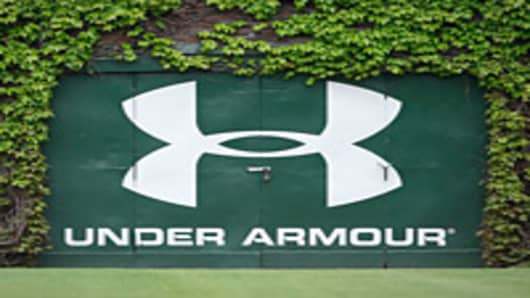Say what you want about the Great Recession, but it certainly was not well-dressed. Bankers bore most of the blame for the 2008 fiscal crisis, but retailers bore plenty of the pain.
Following a quick succession of tightened credit, tumbling home prices, and layoffs en masse, Americans dutifully pulled the plug on shopping, sending shares of classic apparel names like American Eagle Outfitters, Talbots, and Coldwater Creek to their lowest levels in years.
Like most of the economy, retail has recovered from its darkest days, with the S&P Retail index up 120 percent since March 2009. But athletic apparel maker Under Armour has taken the traditional story of a comeback and super-sized it, betting that a combination of superior products, branding, and sponsorships can catapult the company past its competitors and beyond a one-time fashion fad.
Under Armour’s unorthodox story began in 1996 when Kevin Plank, an ex-football player from the University of Maryland, envisioned a groundbreaking T-shirt that expelled sweat rather than absorbed it. Plank successfully crafted the perfection he sought, but his vision came with a hefty retail price tag: $25.
Even so, his specialty apparel quickly earned a reputation as a brand favorite among consumers of all incomes, and he took his company public in 2005. Shares of Under Armour were initially well-received on Wall Street, but later felt the heat of the crisis just like everyone else, with the stock dipping below $13 per share in 2009.
Yet, while many companies were lucky enough to survive the recession, Under Armour came out swinging, ending 2010 with shares trading above $54, and with revenue passing the $1 billion mark. Today, the company’s stock has surged more than 450 percent since the market bottomed, making gains recorded by rivals Adidas and Nike in the same period seem almost negligible.
Under Armour may have already proven itself as a stock winner, but its finish line is nowhere in sight. CEO and Chairman Plank explained to CNBC’s “Squawk Box” that “thought leadership is at the heart of everything we do,” and his expansion plans are more ambitious and inventive than ever.
Last week, he announced plans to double revenue to $2.1 billion by the end of 2013, going beyond the company's 70 percent apparel focus and growing other product lines such as mouthguards and footwear.
Plank says product expansion is a risk he can afford to take, because he has already cemented the trust of his customers. And now that Under Armour’s profits have moved into the big leagues, so has its sponsorships. It recently inked a multi-year, multi-million dollar deal with NFL star Tom Brady to showcase the company's fall line-up, which includes the science-defying, water-repellant Charged Cotton Storm sweatshirt.
And if Brady’s much-photographed supermodel wife just so happens to sport Under Armour’s gear, too, that could be even further proof of Under Armour’s visionary leadership.
Questions? Comments? Email us at consumernation@cnbc.com. Follow Christina Cheddar Berk on Twitter @ccheddarberk.


